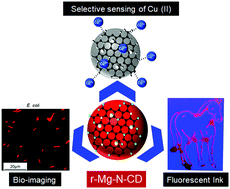Self-doped nontoxic red-emitting Mg–N-embedded carbon dots for imaging, Cu(ii) sensing and fluorescent ink
Abstract
Presently, the doping of carbon dots (CD) with heteroatoms and metal-salts as external dopant is a common practice for enhancing its optical efficiency. This approach can involves the use of biomaterials such as plant leaves since they already possess metals inside as an essential element. In this study, the simple process of carbonization of a leaf extract yielded red-emitting magnesium–nitrogen embedded (self-doped) CD, which were denoted as r-Mg–N-CD, possessing a quantum yield value of ∼41%. Importantly, r-Mg–N-CD was proven to be a biocompatible probe based on the bacteriological test performed on two different bacterial strains, Escherichia coli (E. coli) and Proteus vulgaris (P. vulgaris). In addition to the conventional imaging application, r-Mg–N-CD could also be used for the fluorescence-based selective sensing of Cu(II) metal ions among various heavy metals with a detection limit as low as 50 nM and as red-emitting fluorescent ink.



 Please wait while we load your content...
Please wait while we load your content...